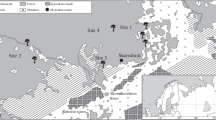Abstract
This paper considers mass materials related to the feeding of the eagle owl from three latitudinal regions of the Urals (northern and southern taiga and steppe). All collections were carried out in the same type of location of bone remains of prey from pellets at the nesting grounds of eagle owls in niches and caves at cliffs along riverbanks. The prey of the eagle owl is divided into three categories: main, alternative, and concomitant. The paper shows the degree of correspondence of the proportions of individuals of different species and their groups in the diet of the eagle owl and the population of rodents in the environs of nesting areas. The importance of separate consideration of the main and other prey of the eagle owl in reconstruction of the composition of the fauna and structure of the rodent population based on subfossil ornithogenic materials is emphasized.



Similar content being viewed by others
REFERENCES
Andrews, P., Owls, Caves and Fossils: Predation, Preservation and Accumulation of Small Mammal Bones in Caves, with an Analysis of the Pleistocene Cave Faunas from Westbury-sub-Mendip, Somerset, UK, Chicago: Univ. of Chicago Press, 1990.
Smirnov, N.G., Votyakov, S.L., Sadykova, N.O., et al., Fiziko-khimicheskie kharakteristiki iskopaemykh kostnykh ostatkov mlekopitayushchikh i problema otsenki ikh otnositel’nogo vozrasta (Physicochemical Characteristics of Fossil Mammal Bone Remains and the Problem of Estimating Their Relative Age), part 1: Termicheskii i mass-spektrometricheskii elementnyi analiz (Thermal and Mass-Spectrometric Elemental Analysis), Yekaterinburg: Goshchitskii, 2009.
Pukinskii, Yu.B., The Eurasian Eagle Owl, in Ptitsy Rossii i sopredel’nykh regionov: Sovoobraznye, Kozodoeobraznye, Strizheobraznye, Raksheobraznye, Udodoobraznye, Dyatloobraznye (Birds of Russia and Neighboring Countries: Strigiformes, Caprimulgiformes, Apodiformes, Coraciiformes, Upupiformes, Piciformes), Moscow: Nauka, 1993, pp. 270–289.
Shepel’, A.I., Khishchnye ptitsy i sovy Permskogo Prikam’ya (Birds of Prey and Owls of the Perm Kama Region), Irkutsk: Irkutsk. Gos. Univ., 1992.
Mikkola, H., Owls of Europe, London: T. & A.D. Poyser, 1983.
Martinez, J.A. and Zuberogoitia, I., The response of the Eagle Owl (Bubo bubo) to an outbreak of the rabbit haemorrhagic disease, J. Ornithol., 2001, vol. 142, no. 2, pp. 204–211.
Terry, R.C., The dead do not lie: Using skeletal remains for rapid assessment of historical small-mammal community baselines, Proc. R. Soc. Lond. B: Biol. Sci., 2009, vol. 277, no. 1685, pp. 1193–1201.
Smirnov, N.G. and Sadykova, N.O., Sources of errors during faunistic reconstruction in Quaternary paleozoology, in Chetvertichnaya paleozoologiya na Urale: Sb. nauch. trudov (Quaternary Paleozoology in the Urals: Collected Scientific Papers), Yekaterinburg: Ural. Gos. Univ., 2003, pp. 98–115.
Smirnov, N.G., Melkie mlekopitayushchie Srednego Urala v pozdnem pleistotsene i golotsene (Small Mammals of the Middle Urals in the Pleistocene and Holocene), Yekaterinburg: Nauka, 1993.
Kuzmina, E.A., Smirnov, N.G., and Ulitko, A.I., New data on Late Pleistocene–Holocene small mammal communities from the Ural–Sakmara interfluve, Southern Urals, Quat. Int., 2016, vol. 420, pp. 56–64.
Comay, O. and Dayan, T., Taphonomic signatures of owls: New insights into micromammal assemblages, Palaeogeogr. Palaeoclimatol. Palaeoecol., 2018, vol. 492, pp. 81–91.
Fernández-Jalvo, Y., Andrews, P., Denys, C., et al., Taphonomy for taxonomists: Implications of predation in small mammal studies, Quat. Sci. Rev., 2016, vol. 139, pp. 138–157.
Korpimäki, E., Diet composition, prey choice, and breeding success of Long-eared Owls: Effects of multiannual fluctuations in food abundance, Can. J. Zool., 1992, vol. 70, pp. 2373–2381.
Korpimäki, E. and Norrdahl, K., Predation of Tengmalm’s Owls: Numerical responses, functional responses and dampening impact on population fluctuations of microtines, Oikos, 1989, vol. 54, pp. 154–164.
Gromov, I.M. and Polyakov, I.Ya., Mlekopitayushchie (Mammals), Leningrad: Nauka, 1977.
Bobretsov, A.V. and Luk’yanova, L.E., Dynamics of small mammal community in the piedmont taiga of the Northern Urals, in Sovremennoe sostoyanie i perspektivy razvitiya OOPT Urala: Mat-ly nauch.-prakt. konf. (Specially Protected Natural Areas of the Urals: Current State and Prospects for Development, Proc. Sci.-Pract. Conf.), Yekaterinburg: OOO UIPTs, 2011, pp. 65–72.
Modorov, M.V., Sadykova, N.O., and Sobenin, S.V., The murine rodent community of the Olen’i Ruch’i Nature Park according to the results of catches with cone traps and live traps, in Biosfera Zemli: proshloe, nastoyashchee i budushchee (The Biosphere: Past, Present, and Future), Yekaterinburg: Goshchitskii, 2008, pp. 139–142.
Rudi, V.N., Fauna mlekopitayushchikh Yuzhnogo Urala (The Mammal Fauna of the Southern Urals), Orenburg: Orenburg. Gos. Ped. Univ., 2000.
Bol'shakov, V.N., Vasil’ev, A.G., Vasil’eva, I.A., and Chibiryak, M.V., Population ecology of small mammals in floodplain forests on the Sakmara River, Orenburg oblast, Vestn. Orenburg. Gos. Univ., 2015, no. 10 (185), pp. 104–107.
Vasil’ev, A.G., Bol’shakov, V.N., Vasil’eva, I.A., et al., The fauna of insectivores and rodents in the Guberlinski Hills, Orenburg oblast, Fauna Urala Sibiri, 2017, no. 1, pp. 223–244.
Funding
The work was performed as part of the state order of the Institute of Plant and Animal Ecology of the Ural Branch of the Russian Academy of Sciences and was also partially supported by the Russian Foundation for Basic Research (project nos. 19-04-00507 and 19-04-01008).
Author information
Authors and Affiliations
Corresponding author
Ethics declarations
The authors declare that they have no conflict of interest. This article does not contain any studies involving animals performed by the authors.
Additional information
Translated by L.A. Solovyova
Rights and permissions
About this article
Cite this article
Smirnov, N.G., Kropacheva, Y.E. Main and Concomitant Prey of the Eagle Owl (Bubo bubo) in Problems of Historical Ecology. Russ J Ecol 50, 491–495 (2019). https://doi.org/10.1134/S1067413619050102
Received:
Revised:
Accepted:
Published:
Issue Date:
DOI: https://doi.org/10.1134/S1067413619050102




